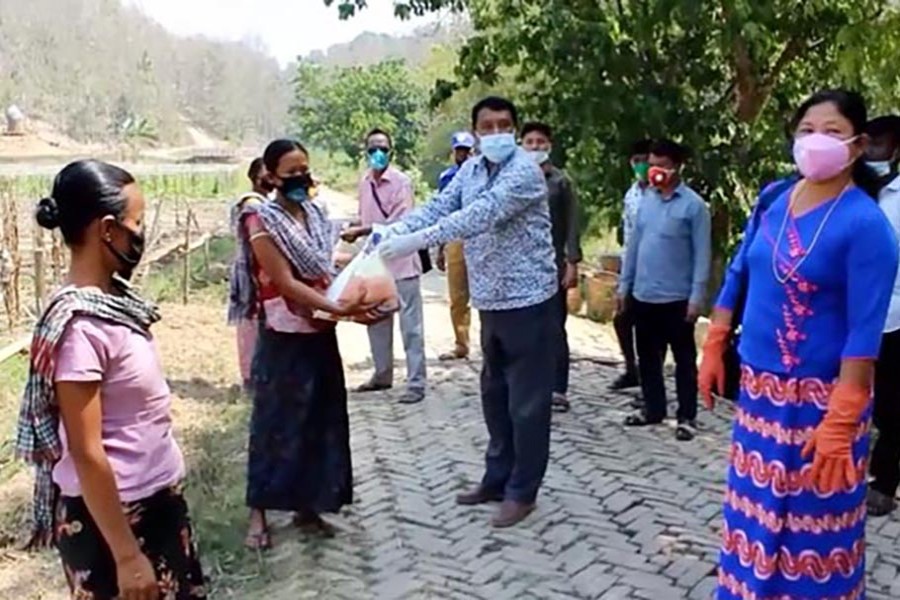Pictures of distribution of victuals among the needy continue to splash pages of newspapers. Alongside government functionaries, city corporations and celebrities, individuals, small organisations and nameless groups have also come forward to feed the hungry mouths whose meagre sources of income have suddenly dried up due to the 'stay home' government instruction. This is encouraging. Against business malpractices and price hike together with some isolated incidents of abuse of government-allocated foodstuffs, such a demonstration of the spirit to stand by the distressed fellow human beings is quite reassuring. Humanity, after all, has not failed to respond to the crisis.
However, not all is well on the distribution front. A look at most of the pictures at the distribution spots gives one a sense of dread. In one of the pictures, a motor-cycle rider with foods for distribution looks baffled when he is surrounded by a number of men and women eager to get their shares. Their proximity was too close for comfort for the distributor as none of them maintained the specified distance and had covered their faces with masks.
Other such pictures are equally disconcerting. People ignored the call for maintaining the minimum physical distance to grab relief items distributed by various social organisations. To such people food surely comes first but ignoring public gathering may prove disastrous. In Delhi a religious congregation has proved how fatal gathering of people anywhere can be. If the way people were pictured to jostle with each other to grab a packet continues at all distribution spots, the ripple effect of infection could lay waste an entire area.
Urban-centric as the food distribution programme mostly is, it has to be managed in a most disciplined manner and immediately before waves of relief-seekers overwhelm the distribution system. An instance, however, illustrates that such rush can be avoided if systems are developed efficiently. A man from Pikepara, Mirpur, according to a report, contacted the official WhatsApp of a police station stating his miserable condition. He related in short that he had no money and would be forced to starve from the evening. Power connection would soon be snapped as he has a balance of Tk 12 only.
An additional deputy commissioner (ADC) of the Dhaka Metropolitan Police (DMP) immediately took steps to help the man. She informed the officer-in-charge (OC) of the relevant police station and the latter under the instruction of the deputy commissioner managed to send rice, pulse and other necessaries to the man. Sharing this on facebook, the ADC has disclosed that they are receiving such calls and messages on a regular basis. In their limited way, the police officials are helping this particular segment of people suddenly finding themselves with no means of living. They are not beggars, homeless or floating people but such ones as teachers of insolvent madrasha or schools, private tutors or tutors who operated coaching centres for lower middle class students or youths who used to collect consumer goods brought by others from India and China for sale. They had a monthly earning between Tk 10,000 and 15,000 and with the income led an honest life.
Now they are most vulnerable as the sources of these people have dried up. They can neither borrow money from their friends because all find themselves in the same boat, nor can they go back to their village home. Even many beggars have their savings but these people cannot save on their meagre income but have to maintain at least a modest standard of life. They will, moreover, feel small if they have to compete with others in a crowd for relief goods.
Now that the BRAC Institute of Governance with its long experience in working for the marginalised poor is going to embark on what has been dubbed 'Rapid Research Response', there is hope that this particular vulnerable category of people will figure along with day labourers and others who live from hand to mouth in the list of recipients of the emergency help. Footpath vendors of an array of household items, toys and dolls are also worst hit with their survival at risk. Unless such people are helped to tide over the crisis, they will simply perish.
Happily, the solvent class and some organisations have shown their readiness to help. But the act of deliverance must be coordinated efficiently so that no one in need is left out or the programmes overlap each other. Here the BRAC's effort can prove crucial. The good thing is that it has expressed its willingness to share its research findings with others caring for the poor and vulnerable.
The important thing is to spot the needy and reach the wherewithal to them. In the case of the Pikepara man, the use of WhatsApp is reasonable but people living in slums can use cell phones to send a distress call. If such helplines are given for making area-wise contact, there is no need for deserving recipients of food aid to throng just any place. Government agencies or volunteers from different organisations will arrive at the given address with the succour. But first such a system has to be developed.


